AMD Reiterates 2013 GPU Plans: Sea Islands & Beyond
by Ryan Smith on February 15, 2013 4:26 PM ESTA few minutes ago AMD wrapped up a somewhat impromptu conference call, which had been called together to reiterate the company’s 2013 GPU plans. While there is technically very little new here that we don’t already know – especially if you can read between the lines on previous AMD announcements – AMD wanted to clarify things after what has been a rather wild week for their PR department. And true to their word, they delivered clarity by the truckload.
Since we’ve been avoiding this ruckus so far until we could get clarification, let’s quickly discuss the past week. The instigator for AMD’s wild week was a somewhat infamous 4Gamer.net article published last Saturday. In that article 4Gamer published the following roadmap slide from AMD, which was then confirmed as real by AMD when multiple AMD Twitter accounted re-tweeted a tweet about the article.
The slide stated, to the amazement of many, that AMD’s product lineup would be “stable throughout 2013”. And although that slide is technically correct, how it’s been interpreted has spawned quite a bit of ballyhoo. It’s this ballyhoo that AMD wants to clear up, hence today’s call.
Diving right into things, for those of you that only follow the desktop side of things, in late 2012 AMD announced their 8000M series products. The 8000M series was a mix of new parts and refreshes in order to satiate AMD’s OEM partners, who are accustomed to having a yearly product cadence of parts so that they can update their laptops accordingly. The fact that this was a mix of rebands and new parts, and that AMD at the time was hesitant to name those parts, made the whole thing murkier than it needed to be for tech enthusiasts, who are accustomed to seeing one or the other.
AMD later confirmed what was what in the 8000M series; the 8500M, 8600M, and 8700M parts were all based on a new GCN GPU codenamed Mars, which was part of AMD’s GCN-based Solar Systems family. AMD at the time also stated that they will be introducing new 8000M parts in Q2 of this year, in the process implying that these will be products based on new GPUs in the Solar Systems family.
Meanwhile in January AMD’s OEM desktop lineup got a similar overhaul. The Sea Islands product family – the desktop code name for the same GPU family as Solar Systems – saw its first product release when AMD announced the 8500 and 8600 OEM families, which were based on the same Oland/Mars GPU that the previous month’s mobile parts were based on. At the same time AMD rebadged a bunch of other desktop 7000 series parts into the 8000 OEM series, with Cape Verde, Pitcairn, and Tahiti products all making the jump.
| AMD Codename Cheat Sheet | |||
| Mobile | Desktop | ||
| London (Family) | Southern Islands (Family) | ||
| Solar Systems (Family) | Sea Islands (Family) | ||
| Mars | Oland | ||
| Chelsea/Heathrow | Cape Verde | ||
| Wimbledon | Pitcairn | ||
The fact that these previous product announcements are seemingly at odds with AMD’s slide is where reading between the lines comes in handy, and unfortunately that’s not a talent that comes naturally. In fact AMD’s mobile roadmap has almost everything you need to know, but you need to be able mesh it with AMD’s published desktop roadmap, which is one of the things today’s call put to rest.
So first and foremost, AMD has reiterated that they’re continuing to work on Sea Islands/Solar Systems, and that we haven’t seen all of the Sea Islands chips yet. At the same time AMD also made clear that Sea Islands is based on the same architecture as Southern Islands – the first generation of Graphics Core Next (GCN1) – and that these parts are essentially just new configurations that we didn’t see with Southern Islands. This is why Oland is architecturally and feature-wise indistinguishable from previous GCN parts, and why it fits in to AMD’s product stack where it does.
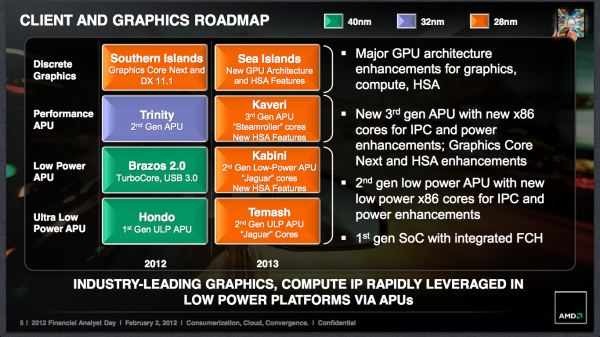
AMD's FAD2012 Roadmap
Of course AMD won’t comment on specific details about future products, but the fact that they have additional chips in the pipeline lines up nicely with their mobile roadmap and when we can expect to see these new Sea Islands GPUs. With their annual rebadging out of the way, AMD’s mobile roadmap makes it clear they intend to replace the 7900M and 7800M (Pitcairn) with some kind of new part, and while AMD won’t give us more details on these parts, replacing them with new Sea Islands parts is virtually guaranteed.
As it turns out, things won’t be all that different on the desktop. As we said before, AMD’s earlier desktop slide is technically correct, it’s just incomplete. AMD’s existing 7000 series cards aren’t going anywhere for the near future, with the flaw in the slide being that it implies that AMD won’t be introducing new products in that time frame. Oland already exists on the desktop in the form of the 8500 OEM and 8600 OEM series, and again with AMD declining to comment on specific details for future products, you should know where this is going. AMD will be introducing new retail desktop 7000 series products in the first half of 2013.
Is it virtually guaranteed (but not confirmed) that at least one of those products be the retail version of Oland. With 384 stream processors, Oland offers performance a step below the existing Cape Verde 7700 series parts and should give AMD the ability to deliver 7000 series functionality at under $100. At the same time, with at least one other Sea Islands GPU in the works, it’s also a strong likelihood that whatever new GPU AMD is introducing on the mobile side in Q2 will see an eventual desktop release in AMD’s H1 2013 timeframe. And to be very clear here, none of this is guaranteed, as AMD has made it clear that a new 7000 series desktop product does not necessarily mean a new GPU. But based on what AMD is saying and what AMD has committed to, Sea Islands is destined to get a retail desktop release.
The fact that these Sea Islands products will be released as 7000 series products is going to throw long-time readers a bit of a curveball, but as we’ve previously discussed Sea Islands is little more than new configurations of GCN1, so they will fit in nicely among the existing 7000 series products. For AMD’s part they believe the Radeon HD 7000 series is a very strong brand at retail – almost unbelievably having sold more 7900 cards in January 2013 than in any month prior – so as opposed to the OEM world where OEMs are driving rebadging and new product numbers, AMD wants to keep the 7000 series on the retail desktop in order to capitalize on their success. Labeling Sea Islands retail desktop parts as members of the 7000 series will allow AMD to introduce new products while still keeping the 7000 branding they’ve become so proud of.
What you’ll note through all of this however is that whenever we talk about the desktop it’s in relation to mobile, and there is a reason for that. Sea Islands is primarily geared for OEM notebooks, a very important market for AMD to tap at a time when laptop sales now outpace desktop sales, and when laptops only continue to grow while desktops shrink. There has been a general trend towards launching laptop-first in the PC industry for the past couple of years, and AMD is now part of that trend. This is why Sea Islands GPUs like Oland are launching as 8000M products first, and only later as desktop OEM and retail desktop parts.
This mobile/desktop distinction is important, but perhaps most so for high-end gamers, as this is necessary to set expectations. So far we’ve continued to point at the AMD roadmap, where AMD’s products top out at Pitcairn-like products. AMD’s mobile lineup never used AMD’s biggest, fastest GPU (Tahiti) for everything from power to cost reasons; these GPUs are best suited for desktops and workstations. What this also means is that if AMD were to focus on refreshing their mobile lineup first and foremost, would they need to refresh their high-end desktop lineup? The answer to that is basically no. AMD has been very careful with their words here, but the gist of matters is that the 7900 series will remain the mainstay of AMD’s enthusiast product line until the end of 2013.
Now AMD has been careful here to always mention the 7900 series and not Tahiti, but so far they are one in the same. AMD’s lack of comments means that we cannot say anything is for sure, but nearly everything about AMD’s presentation was geared around driving home the point that AMD is happy with their current enthusiast products, and indeed that they believe they currently have the fastest products and that they need to do a better job of getting the word out. In other words, while it’s clear that Sea Islands will flesh out the lower end of AMD’s GPU lineup, AMD has been doing everything they can to prepare the press to accept the idea that Tahiti will remain as AMD’s fastest GPU until the end of the year. Sometimes what AMD doesn’t say says it all, and in this case what’s not being said (but being strongly implied) is that AMD will not be coming out with a GCN1 GPU more powerful than Tahiti.
Finally, AMD also used a bit of their time to talk about their plans for the end of the year. With the 7900 series seemingly set as-is for the rest of the year, AMD has formally announced that they will be introducing a new GPU microarchitecture by the end of 2013. GCN is heavily embedded into AMD’s product line, from their SoCs all the way up to their biggest GPUs, so from a business perspective AMD is incredibly reliant on it. But on a technical level it’s also still a fresh, modern architecture whose greatest task – being the GPU component of AMD’s HSA implementation – has yet to come.
Consequently future microarchitectures will be GCN based, as AMD will continue to refine GCN implementations and add features to the architecture, similar to what they did with VLIW5 over the span of 4 years. We don’t typically throw around the word microarchitecture when discussing GPUs, but with AMD’s plans that’s exactly what’s going on; we’re seeing a stratification of things into the all-encompassing architecture (Graphics Core Next) and the individual microarchitectures spawned from it like GCN1 and AMD’s yet-to-be-named microarchitecture.
In any case, AMD’s new GPU microarchitecture will in turn drive a new generation of products that will be introduced at the same time. AMD isn’t saying anything more about what’s to come from that family, but we would note that the timeline for the launch of this new family lines up with how long AMD expects the 7900 to remain their enthusiast mainstay.
Wrapping things up, while there was little new on AMD’s call besides their new microarchitecture, their call did go a long way towards clearing up their previous announcements and giving us a better idea of what to expect from AMD in the next few months. The long and short of it is that while AMD won’t be replacing the 7000 series on the retail desktop, they will be supplanting it with new products, and those products are almost certain to be based on their forthcoming Sea Islands GPUs. Based on what we’ve seen about Sea Islands so far on the mobile side, it should do a good job of fleshing out AMD’s product lineup to cover the gaps and areas where they don’t have direct competition against NVIDIA. At the same time however they clearly won’t be a significant departure from the products we’ve seen so far, and most importantly they won’t be a microarchitecture cadence.
As for enthusiasts, the implication that they’re not going to see anything faster than Tahiti until the next generation products at the end of this year is unfortunately unlikely to go over well. Enthusiasts have become used to annual GPU refreshes, and while they’re still somewhat here as we’re seeing with Sea Islands, that era appears to be coming to a close as microarchitectures improve, development costs go up, and the rate of introduction for new fabrication processes slows. And certainly this is quite a departure from the norm. But if nothing else, AMD is right about a couple of things: as it stands AMD is already competitive with NVIDIA’s contemporary high-end offerings, and they're finally competitive with NVIDIA when it comes to developer outreach. Ultimately with the success of the 7900 series AMD today is in a comfortable place, leaving them free to focus on what they already have and how to improve those sales even further.


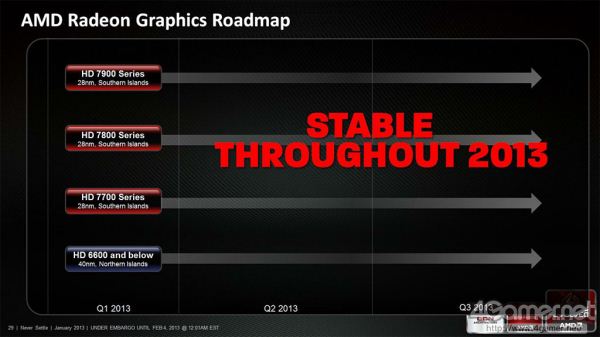
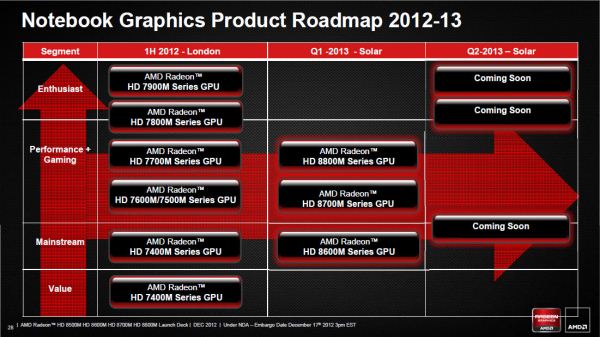
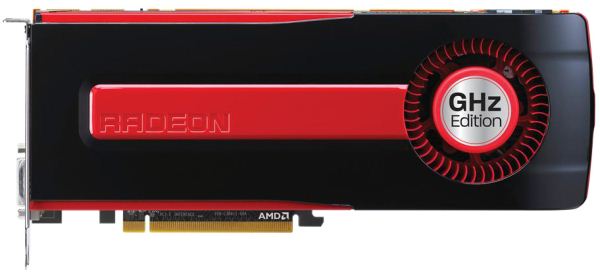
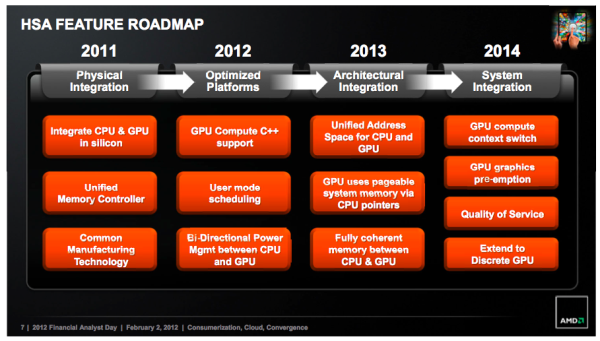








57 Comments
View All Comments
Hubb1e - Friday, February 15, 2013 - link
I'm ok with them slowing down the pace of new GPUs. I typically waited two generations before upgrading anyways, so as long as the performance increase of the next high end part is high, I'll be in the mood to upgrade again after only one generation so it doesn't' really impact me much. Plus, my old part will probably be worth more on the used market too.HanakoIkezawa - Friday, February 15, 2013 - link
I'm fine with this as well. I just hope they have a large generational jump if they are taking two years to do it.Ryan Smith - Friday, February 15, 2013 - link
Any generational jumps are ultimately dictated by TSMC, since as it stands high-end desktop GPUs are power-limited. The greater the power reduction from 20nm, the more they can crank things up.chizow - Friday, February 15, 2013 - link
Very true, but as we've seen with Intel and Nvidia, greater transistor and TDP budget from improved process nodes does not mean they will release a maxed out part that significantly outperforms the previous generation.Nvidia held BigK back for whatever reasons.
Intel is using it's increased transistor budget on GPU rather than CPU.
I'm generally OK with the slowed pace of product launches, I just hope people get wise to the fact they don't have to upgrade if the increase in performance doesn't warrant the price tag.
ET - Tuesday, February 19, 2013 - link
I think that people are generally wise to this, and that part of the reason to hold off is that all a new generation would do at this point is to drive prices down, making even lower end parts enough for the majority of situations. It probably makes some sense to wait until the new consoles are released, and hope that games for them might drive an upgrade cycle on the PC.thetuna - Friday, February 15, 2013 - link
I also subscribe to the two generation cycle, too bad this was supposed to be my upgrade year :(MrSpadge - Saturday, February 16, 2013 - link
Well, the current cards are pretty nice.. depending on what you currently own. And you can plug in a new GPU anytime, no need to adjust it with other updates.JonnyDough - Sunday, February 17, 2013 - link
Agreed. Prices drop, and many of us now have SLI/Crossfire capable motherboards. SLI and Crossfire both scale pretty well today so there isn't a lot of reason not to throw a 2nd card in.CloudFire - Saturday, February 16, 2013 - link
Same here, I wanted the 8xxx to come out so I can sell my 6870 xfire. It's running great for me but I like to run my games on max settings and the 1gb ram is showing it's age in titles with heavy AA like BF3. I prefer a single gpu from now.Alexvrb - Sunday, February 17, 2013 - link
There are some nice looking factory overclocked 7970s starting at $400-430. Or you could wait it out.